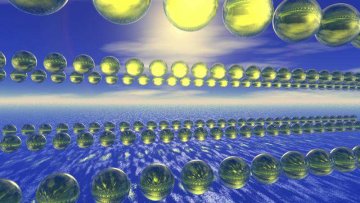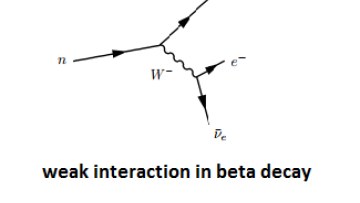Oxford Mathematician Ali El Kaafarani explains how mathematics is tackling the issue of post-quantum digital security.
"Quantum computers are on their way to us, not from a galaxy far far away; they are literally right across the road from us in the Physics Department of Oxford University.
16:00
Thick triangles and a theorem of Gromov
Abstract
A theorem of Gromov states that the number of generators of the fundamental group of a manifold with nonnegative
curvature is bounded by a constant which only depends on the dimension of the manifold. The main ingredient
in the proof is Toponogov’s theorem, which roughly speaking says that the triangles on spaces with positive
curvature, such as spheres, are thick compared to triangles in the Euclidean plane. In the talk I shall explain
this more carefully and deduce Gromov’s result.
Incorporating Brownian bridge time integrals into numerical methods for SDEs
Abstract
Numerical methods for SDEs typically use only the discretized increments of the driving Brownian motion. As one would expect, this approach is sensible and very well studied.
In addition to generating increments, it is also straightforward to generate time integrals of Brownian motion. These quantities give extra information about the Brownian path and are known to improve the strong convergence of methods for one-dimensional SDEs. Despite this, numerical methods that use time integrals alongside increments have received less attention in the literature.
In this talk, we will develop some underlying theory for these time integrals and introduce a new numerical approach to SDEs that does not require evaluating vector field derivatives. We shall also discuss the possible implications of this work for multi-dimensional SDEs.
Oxford Mathematician Yuuji Tanaka describes his part in the advances in our understanding of gauge theory.
Lie brackets on the homology of moduli spaces, and wall-crossing formulae
Abstract
Let $\mathbb K$ be a field, and $\mathcal M$ be the “projective linear" moduli stack of objects in a suitable $\mathbb K$-linear abelian category $\mathcal A$ (such as the coherent sheaves coh($X$) on a smooth projective $\mathbb K$-scheme $X$) or triangulated category $\mathcal T$ (such as the derived category $D^b$coh($X$)). I will explain how to define a Lie bracket [ , ] on the homology $H_*({\mathcal M})$ (with a nonstandard grading), making $H_*({\mathcal M})$ into a graded Lie algebra. This is a new variation on the idea of Ringel-Hall algebra.
There is also a differential-geometric version of this: if $X$ is a compact manifold with a geometric structure giving instanton-type equations (e.g. oriented Riemannian 4-manifold, $G_2$-manifold, Spin(7)-manifold) then we can define Lie brackets both on the homology of the moduli spaces of all $U(n)$ or $SU(n)$ connections on $X$ for all $n$, and on the homology of the moduli spaces of instanton $U(n)$ or $SU(n)$ connections on $X$ for all $n$.
All this is (at least conjecturally) related to enumerative invariants, virtual cycles, and wall-crossing formulae under change of stability condition.
Several important classes of invariants in algebraic and differential geometry — (higher rank) Donaldson invariants of 4-manifolds (in particular with $b^2_+=1$), Mochizuki invariants counting semistable coherent sheaves on surfaces, Donaldson-Thomas type invariants for Fano 3-folds and CY 4-folds — are defined by forming virtual classes for moduli spaces of “semistable” objects, and integrating some cohomology classes over them. The virtual classes live in the homology of the “projective linear" moduli stack. Yuuji Tanaka and I are working on a way to define virtual classes counting strictly semistables, as well as just stables / stable pairs.
I conjecture that in all these theories, the virtual classes transform under change of stability condition by a universal wall-crossing formula (from my previous work on motivic invariants) in the Lie algebra $(H_*({\mathcal M}), [ , ])$.
16:00
Moments of cubic L-functions over function fields
Abstract
I will talk about some recent work with Chantal David and Matilde Lalin about the mean value of L-functions associated to cubic characters over F_q[t] when q=1 (mod 3). I will explain how to obtain an asymptotic formula with a (maybe a little surprising) main term, which relies on using results from the theory of metaplectic Eisenstein series about cancellation in averages of cubic Gauss sums over functions fields.
16:00
Recent progress on the theory of free boundary minimal hypersurfaces
Abstract
In a given ambient Riemannian manifold with boundary, geometric objects of particular interest are those properly embedded submanifolds that are critical points of the volume functional, when allowed variations are only those that preserve (but not necessarily fix) the ambient boundary. This variational condition translates into a quite nice geometric condition, namely, minimality and orthogonal intersection with the ambient boundary. Even when the ambient manifold is simply a ball in the Euclidean space, the theory of these objects is very rich and interesting. We would like to discuss several aspects of the theory, including our own contributions to the subject on topics such as: classification results, index estimates and compactness (joint works with different groups of collaborators - I. Nunes, A. Carlotto, B. Sharp, R. Buzano - will be appropriately mentioned).




